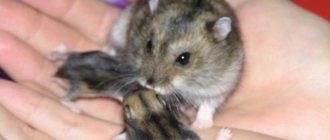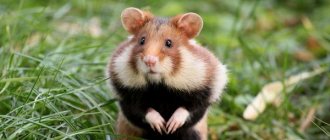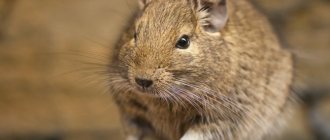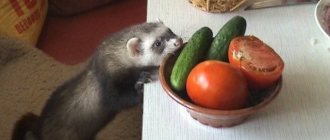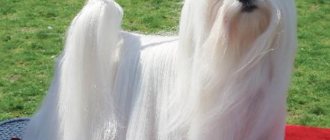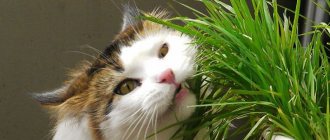Meeting a furry animal
The Syrian hamster is a rodent belonging to the hamster family. Its other name is “golden hamster”, which it received due to its reddish-yellow fur. Animals of this breed can be colored not only golden, but also white, brown, black, and silver. The classic Syrian hamster is short-haired, but currently long-haired variations of this species have also been bred. The length of the body of Syrian hamsters ranges from 13 to 18 cm, weight fluctuates around 100-200 g.
The rodent's body is stocky, its legs are short, its ears are rounded, its muzzle is short, its eyes resemble convex beads, and it has a short tail, which is not easy to find in the thick fur. The abdomen is lighter than the back, like all rodents. The hind feet have five toes, the front feet have four, and there is also a rudimentary fifth. A distinctive feature of hamsters is their cheek pouches; the Syrian breed also has them, and it uses them fully. The active phase of an animal’s life in nature occurs at night.
Before getting any pet - be it a turtle, snail, rabbit, jerboa, degu, guinea pig, siskin, crossbill, parrot - you should study the features of caring for it.
The animals are clean and hardy. They are active, funny and curious, become attached to their owner and can be trained, and do not show aggression towards people. Females have virtually no scent, but males prefer to carefully mark their territory.
First described in the late 18th century, the Syrian hamster has a long, fascinating and intricate history of distribution, breeding, study and selection.
Did you know? The Syrian hamster was listed in the Red Book as an endangered species.
What to look for when purchasing
When purchasing an animal, you should pay special attention to the following points:
- Appearance of a rodent . The coat is shiny, glossy, thick and without bald spots. The animal is well-fed and well-groomed. There are no scars on the skin or ears. The area around the anus looks healthy and dry.
- Eyes. Shiny, not dull, clean, without discharge or stains.
- Nose. Clean, no discharge.
Important! You should not buy an animal that is under stress.
—
his defense mechanisms are weakened and may not cope with adaptation to new living conditions.
- Activity. A healthy hamster is curious and active, but without fanaticism. Both apathetic behavior and overly energetic behavior should alert the buyer. A balanced animal will not fearfully shy away from an outstretched hand and be afraid of being held. If there is such behavior, it means that his psyche is disturbed due to insufficient treatment. This state of affairs can be corrected if you wish and have time and patience.
Important! You should know that the reflex reaction of a hamster to a stimulus is that it turns on its back and, sticking out its paws, tries to push away the frightening stimulus. This behavior can be corrected during the process of domestication.
- Age. It is better to buy an animal aged from one to three months, so it will be easier for him to adapt to a new home, and the younger he was at the time of purchase, the longer you can enjoy communicating with your pet.
What to feed your Syrian hamster?
join the discussion
Share with your friends
Hamsters, including Syrian ones, can please their owners, but only on one condition that the food is organized correctly. There is no point in experimenting when you can learn the main points from standard recommendations.
How to find out age and gender
When choosing a pet, you should pay attention to its age and gender, which will largely determine its lifespan, behavioral characteristics and reproductive capabilities.
It is advisable to prefer an animal that already feeds on its own, that is, older than 1 month, and prone to rapid learning, taming, litter box training, etc., that is, no older than three months.
Determining age
You can trust the seller's assurances about the age of the hamster, but it is quite possible to try to determine how many weeks old he is on his own. In any case, this will be approximate information, accurate information is not available even to specialists. For ease of orientation, hamsters are divided into:
- young;
- adults;
- old
The behavior of a young individual differs from that of an old hamster.
- Young hamsters are active, curious, funny and quite voracious, while old ones prefer sleep to play and even sometimes feeding.
Did you know? By human standards, a year in the life of a hamster corresponds to a quarter-century human lifespan.
- Young people have thin light fur on their ears, while old people lack it.
- Cloudiness of the eyes indicates old age, and it also signals certain diseases. In all cases, it is better to refrain from buying a hamster with cloudy eyes: such a pet will live for a very short time. Young individuals have brilliant eyes, full of curiosity and a thirst for exploration. Such animals, if well cared for, can live to a respectable hamster age in your family.
- There is practically no fur until the age of five days; by the age of 15 days the baby may still not be completely covered with it. Young fur is brightly colored, and if there are bald patches on such a coat, this may not indicate illness, but extreme youth, up to one month. It is better to refrain from buying such a young specimen; it will have to be artificially fed, and it is not a fact that the undertaking will end happily. The fur of adult animals is hard, while that of young and healthy animals is soft and silky.
- A hamster that is less than 3 months old is unlikely to weigh more than 40 grams. An adult will “pull” 110-120 grams. Babies weigh from 2 to 4 grams, depending on the number of cubs in the litter, and it can range from 4 to 15 hamsters.
Determining the sex
It would be useful to find out how to determine its sex before buying a Syrian hamster. The animal should be taken by the scruff of the neck and lifted. Once in this position, he stretches out his body and spreads his legs, after which it is not difficult to study his genitals.
Sex determines the distance between the rodent's genitals and its anus. For males this distance is greater than for females, as can be seen from the figure: for the former it is from one to one and a half centimeters, for the latter it is only about 3 millimeters.
Already at 4 weeks of age, the male’s testicles are clearly visible, which look like swollen, rather large formations near the base of the tail. In sexually mature males, the glands located on the abdomen actively produce secretions, and therefore their bellies are constantly wet.
Singles or need neighbors
If you want to buy several hamsters, you need to know that each one will need its own individual cage. While affectionate and funny with their owners, they treat their own kind completely differently. Being territorial animals, these rodents will fight for territory and compete to the last, and if the weaker one has nowhere to go to hide from the wrath of an opponent, he will be killed.
Staying together is possible only for a few minutes during mating, naturally, under the supervision of an adult, responsible person who is able to recognize and react if a romantic date has turned into a fight, and to seat the unsuccessful couple.
If there are many questions about keeping hamsters in the same apartment with predators, then proximity to fish - minorcas, cockerels, guppies, laliuses, astronotuses, platies, barbs, gouramis, veiltails - will not harm anyone.
The rest of the time it is unacceptable to keep hamsters in a common cage.
Pregnant females
When preparing for breeding, you should know that a pregnant female needs:
- boiled chicken meat;
- boiled yolk;
- skim cheese;
- greens, sprouted grains;
- increased amount of protein food: gammarus, earthworms, grasshoppers, butterflies (necessarily purchased in specialized pet stores).
During the gestation period, the volume of feed is increased so as not to cause concern to the mother due to lack of supplies. A piece of coal, a mineral stone, and calcium gluconate are placed in the cell.
Life expectancy at home
Of all the decorative breeds, it is Syrian hamsters that are considered “long-livers” at home; it is unfortunately impossible to say exactly how many years of life they have, but on average they live about 2.5 years.
Did you know? There are cases when, with proper care, a pet lived up to 4 years of age, and some individuals
-
up to 7 years!
And this is a very decent period in comparison with the one and a half year that is given to the Syrian hamster in the wild. The lifespan of a rodent depends greatly on what it eats and in what conditions it lives. In nature, animals are sometimes forced to starve, die from disease and become prey to predators.
List of approved products
For adults
Given that Syrian hamsters live in meadows and forest-steppes, they love grains and seeds most of all. The easiest way to provide your pet with analogues of such food is to purchase ready-made mixtures. When compiling them at enterprises, specialists mix:
- alfalfa;
- wheat;
- corn kernels;
- oats;
- sunflower seeds;
- red millet
But mixtures may also include other components. For example, walnuts, buckwheat, split peas, flax grains, peanuts and sesame are added there.
It is important to know that you should not “lean” excessively on fatty seeds and nuts - their excess can be dangerous for a hamster. It is advisable to give fatty foods as treats - then the animal will not be at risk of obesity.
When preparing your own seed mixture for your pet, you can be absolutely sure of the quality of all components. It is recommended to add pumpkin, melon and watermelon seeds. Thanks to them, you can make your diet more varied and deliver many useful substances. But all supplements should be consumed in limited quantities. In addition, you should refrain from unnecessary experiments and consult a specialist before doing so.
The volume of ready-made cereal grain mixtures can be up to 0.06 kg per day. It is important to know that grain is occasionally exchanged for white bread. Since the animal is a rodent, dried corn grains and seeds will be a delicacy for it.
Your daily diet must include apples, carrots, and bell peppers. Among field greens, clover, plantain, and dandelion leaves are suitable.
We must not forget about supplying the animal with protein. Two or three times a week the following is added to food:
- skim cheese;
- hard-boiled egg;
- boiled chicken;
- low fat fish.
All animal products must be thoroughly cooked to prevent fiber retention.
Plant foods can also be a valuable source of protein. Give boiled or dried peas, beans or chickpeas. The animal will also be happy with kefir. Hamsters should be fed in the mornings and evenings, given that Syrian hamsters often feed at night.
A monotonous diet is categorically unacceptable. You can add a variety of cereals and dried fruits to dry food. Carrots and pumpkin, zucchini, cucumbers, radishes, and bell peppers can be added either raw or lightly boiled. Be sure to put in the feeder:
- pear;
- persimmon;
- mango;
- beets;
- strawberries;
- raspberries;
- other forest and garden berries;
- lettuce leaves;
- scalded leaves of young nettle.
For babies
Young Syrian individuals have an underdeveloped, still very delicate digestive system. For this reason, the nutrition of small hamsters should be based on a special scheme. Animals should receive food often, but in small portions. Dry grain mixture should be continuously added to the feeder. It is important to note that not all small hamsters like this product.
When dispensing fresh herbs and fruits, it is necessary to add no more than one type of food during the day, otherwise it can cause harm to digestion. For a similar reason, you should avoid eating exotic fruits. Sprouting at home can give good results:
It is useful to draw up a nutrition plan in advance and strictly follow it.
To ensure the normal development of pets, young plant shoots must be added - they will saturate the body with microelements. At one month and even earlier, many hamsters feed on human baby food. The motive is simple - it contains meat, cereal and vegetable components.
The topic of nutrition for adult hamsters is also quite relevant. This group includes all animals from 2 years of age and older. Characteristic signs are apathy and decreased appetite. But, even without closely observing the animal, it is easy to notice that its teeth are almost worn down. For this reason, you will have to completely abandon rough food.
Nuts and hard grains are ground to a mushy state. It is better to grate all vegetables and fruits - it is better to do this even with bananas, tomatoes, and dill. You can still use ready-made dry formulations - with their help it is possible to stabilize the functioning of digestion.
It is recommended to feed the “oldies” basically the same food as the babies.
For pregnant females
The food in the diet of this group of individuals should provide a maximum of microelements. It is better if a lot of food containing protein is provided once a day. You also need fresh greens and cereal sprouts. There is no need to complain about lack of appetite at this time. Moreover, the animal will worry if its feeder is empty.
Choosing and arranging housing
Choosing housing for your pet is not a problem these days: pet stores provide a huge selection to suit every taste and budget. The optimal cage size for a Syrian hamster is 60x40x25. The bars in such a cage are located vertically, which will allow the pet to climb on them - this is one of his favorite activities; the width between them is 10 millimeters for this breed.
If for some reason you have chosen a plastic aquarium, its dimensions should be 50-60x40x30-40 centimeters.
Its well-being and life expectancy largely depend on the equipment of a hamster’s home.
Litter
Wooden sawdust of medium fineness is well suited for bedding. To the same extent, pressed sawdust sprinkled with shavings would be appropriate. This material has good properties; it absorbs moisture and odor.
The following materials are not suitable for bedding:
- napkins;
- cotton wool;
- rags;
- newspaper.
Toilet
Hamsters are well accustomed to a tray that can be purchased commercially - a special one for use by small rodents.
Along with the tray, it is worth purchasing a special filler, which is small granules that perfectly absorb unpleasant odors. This option, although it requires some investment, is the most convenient for the rodent owner. The filler in it usually requires replacement no more than once a week.
Did you know? Hamsters are very smart, amenable to training and can learn several funny tricks, the performance of which will bring joy to both the animal and its owner.
If you bought a young hamster, it will not be difficult for you to accustom him to the litter box, but if the animal has reached adult hamster age and already has his own concept of the toilet, you will not be able to retrain him, you will have to provide him with the toilet to which he is accustomed.
Manholes and wheel
In nature, a hamster’s personal territory is very vast; it is unlikely that it will be possible to recreate such conditions for a pet in an apartment or even a house.
Did you know? In one night, a hamster is able to “run” around the cage up to 12 kilometers, while developing a speed of up to 3.6 km/h.
For climbing in the cage, install:
- tree;
- special tubes;
- labyrinths;
- branches or roots.
The running wheel is selected based on the size of the pet.
It is attached to the wall of the cage or installed freely and allows the animal to “wind up” the mileage it needs. The wheel must have transverse protrusions and a non-slippery bottom without a grid. Important! Any wooden parts brought from the street for a pet should in no case be affected by rot, fungi and other pathogenic microorganisms.
In any case, even if the wood appears healthy, it should be subjected to special disinfection treatment before offering it to your pet. Holiday house
Special housing that plays the role of a hole for a hamster should not be too small. The pet will sleep there and, most likely, will store food supplies.
It is convenient if this device is attached to the cage wall, easily removed and opened for washing and disinfection. The material should not be varnished wood, low-quality plastic or any other substance whose particles can harm the animal’s digestive system.
Did you know? In nature, one hamster is able to make a huge food supply
-
up to 90 kilograms of all kinds of food!
Some individuals prefer to build a nest of sawdust right at the bottom of the cage, ignoring the proposed devices.
Drinking bowl
The volume of the water container should be small, about 50 ml. The water must be changed every day, regardless of how much your pet drinks.
Some rodents do not like water at all; they satisfy their thirst with succulent food.
Important! It should be noted that the hamster will constantly move the bowl of water, splashing out its contents and moistening the bedding material. This situation must be excluded
—
a moist, warm environment is ideal for the development of pathogens. Feeder
This device can be bought or made with your own hands. Its width ranges from 3 to 10 centimeters, depending on the size of the pet, the height of the side is 1.5 centimeters. A medium-sized lid is suitable for this purpose.
Prohibited Products
Some harmless products can be dangerous for both Syrian and Djungarian hamsters. List of what you should not feed them:
- food intended for parrots or other rodents;
- acorns, chestnuts, potatoes;
- cheese, lard, any products containing more than 3% fat;
- spices;
- almond;
- dairy products;
- sweets, juices;
- fatty food;
- white cabbage is dangerous and fatal;
- garlic, onion;
- chocolate;
- citrus, exotic fruits;
- seeds, seeds of any fruit;
- captured insects that are not typical for the diet of dwarf birds;
- canned, stewed, fried, smoked foods;
- butter.
The Syrian hamster has a lot of positive emotions, joy, laughter, and is not picky about food. But you need to feed him correctly, understanding that his well-being and life expectancy are influenced by proper maintenance, a balanced diet, and tender and kind feelings towards the pet.
Source
Where to put a house in an apartment
Not every corner of your apartment is suitable for housing a hamster.
- This is a nocturnal animal; day for it is a time of sleep and rest. It is better if the cage is located in a place that is not very visited during the day. Despite the need for a quiet place, it is desirable that the animal is in sight.
- Nocturnal rodents are particularly sensitive to vibrations, so you should place your pet away from the TV, computer, washing machine and other devices that make noise.
- Their eyes are not adapted to daylight and bright light, the pupil does not contract, so a place near a window or other light source is not suitable for a hamster; the lighting will constantly harm the animal’s vision.
- For the convenience of observing the life and habits of your pet - you get him in order to enjoy communication - it is better to place the cage at eye level: on some table or cabinet.
- It is very desirable to make two walls of the cage opaque: one is usually placed against the wall, and the second is screened.
- The temperature should not go beyond 12-25°C. If it temporarily becomes colder, it is unlikely to cause harm to the animal, but an increase in temperature will speed up already rapid metabolic processes, which will not benefit the animal’s life expectancy. Based on what has been said, we can conclude: it is impossible for the cage to stand near a heat source: a battery or a heater. It is advisable to avoid temperature changes.
Important! The Syrian hamster hibernates if the air temperature drops below 8
°C
, it is better to avoid this load on his body.
- The cage should be located away from drafts and smoking areas, but it is important that the space is ventilated and there is no air stagnation.
- It is absolutely unacceptable for another animal, such as a cat or dog, to have access to a rodent. Predators can be very inventive in overcoming obstacles in the form of latches and the like, and for a hamster such a neighborhood can end very badly.
- There should be no curtains, clothes, indoor plants or other objects and materials near the cage that the animal can drag inside.
Diet
Hamsters are fed twice a day; this regime meets their physiological needs and is convenient for the owners. The required amount of food depends on the age, size, individual characteristics of the rodent and the temperature of the air in which it lives. It is easy to determine how much food your pet needs - the next day there should be some left in the feeder.
Many people prefer store-bought, specialized, balanced food and all kinds of store-bought treats as a supplement. The latter bring pleasure to the animal and grind down its incisors well.
Important! It is imperative to check the production date and expiration date of the purchased industrial feed.
In their natural habitat - the steppe and desert - hamsters often lack water; they have long learned to obtain the necessary moisture from succulent food. Some individuals can do without water at all, but it is still better to have a drinking bowl in the cage. It can be removed only if you are absolutely sure that the pet does not have a fluid deficiency and receives it in full from the food.
For a complete and varied diet, the animal should, in addition to solid food, be given vegetables, berries and fruits.
Important! It is necessary to thoroughly wash all products that you intend to offer to the animal.
Like other animals, hamsters have their own food preferences, which are revealed in the process of communicating with them.
It is necessary to ensure that the rodent’s diet is varied and balanced, and that the diet is based on healthy light foods.
Among Syrian hamsters there are often gluttons who are prone to gaining excess weight, which needs to be monitored by weighing the pet on a scale or determining its approximate weight. The weight of an adult should not exceed 200 grams or be below 100 grams. The female weighs more than the male.
If your pet is “overweight”, he should be put on a diet and make sure that he has enough opportunities for physical activity. It’s not a sin to push a young, fat, lazy person into this activity, naturally, without overdoing it in this matter. The diet is excluded for babies, pregnant and lactating hamsters.
Did you know? The Syrian hamster's cheek pouches are capable of supporting 20% of their owner's weight.
Let's look at what you can and can't feed your Syrian hamster so that its life at home is as long and healthy as possible.
The diet of the Syrian hamster allows for the presence of:
- Cereals: oats, millet, barley, buckwheat, rice, wheat, especially sprouted.
- Legumes: peas and boiled beans, occasionally and little by little - peanuts.
- Seeds: sunflower, pumpkin, melon.
- Fresh or dried corn.
- Herbs: legumes and cereals, clover, dandelion in small quantities, nettle, sedge, burdock, plantain, parsley, dill, lettuce, celery, and hay in winter.
- Vegetables: carrots, pumpkin, zucchini, cucumber, radish, turnip.
- Fruits: apples, pears, persimmons, bananas, berries, dried fruits.
- Dairy products: cottage cheese and milk.
- Meat and fish products - exclusively boiled without salt, low-fat and in small quantities.
- High-quality vitamin complexes for hamsters.
Regular milk, even if boiled, is not advisable to give to rodents, especially young ones.
It is better to prefer a freshly prepared milk powder product. The freshness of milk is more important the smaller the creature consuming it. It is also necessary to include non-acidic cottage cheese in the diet, but yoghurt, kefir and other fermented milk products have too high acidity, in addition, store-bought products may contain additives that can harm the miniature body. In addition to kefir and yogurt, the following is prohibited in a hamster’s diet:
- Salt and sugar.
- Spices and herbs.
- Zhirov.
- Citrus and other exotic fruits.
- Nuts, seeds and fruit seeds.
- Cabbages.
- Chocolate.
Approximate diet of a Syrian hamster
- Half-raw wheat, oatmeal or buckwheat porridge with baby formula - for hamsters up to a month, twice a day, after a month - once. For adults - store-bought or prepared dry food.
- Sweet apple - in the morning feeding.
- Carrots - in the evening feeding.
- Boiled unsalted low-fat chicken or fish - every other day in the evening feeding.
- Pumpkin or sunflower seeds - every other day, alternate.
- Greens or sprouted wheat in winter - 1 time every other day.
- There is always a mineral stone in the cage, not a salt one.
Some feeding principles should be followed:
- Gradual introduction of a new product into the diet followed by an increase in dose.
- Thorough rinsing of all products.
- Prohibition of cold food, for example, fresh from the refrigerator.
- Spicy, salty, sweet, and canned foods are strictly prohibited.
Sick and weakened rodents
Often, after suffering stress, the animal gets sick. The disease can be caused by a new place of residence, moving, the appearance of a roommate in a cage, or a loud TV. If there is aggression, hair loss, parasites, skin inflammation, lethargy, or refusal to eat, you should visit a veterinarian.
Often such animals have to be force-fed, using grains crushed to a puree, ground, mixed with hot water or vegetables into a syringe. Food is served warm. Mashed potatoes and cereals are suitable for children. It is convenient to mix vitamins and medicines there. Sick Syrian hamsters are given chamomile infusion. They do this slowly, making sure that the hamster does not choke.
Care and hygiene
Hygiene measures come down to periodic cleaning of the cage, cleaning all items that the pet uses and replacing the bedding. This procedure is carried out approximately every five days to a week, or as the actual contamination occurs.
Important! While the occupant is being cleaned, the cages are moved to a safe place.
Every month, the cage and all items should be treated with a disinfectant with bleach, after treatment, rinse well, wipe thoroughly and dry.
The drinking bowl and feeder are cleaned and washed daily.
Keeping a Syrian hamster is not particularly difficult, since the animal is generally independent and is capable of caring for itself.
Fur
If it is heavily soiled, wipe it with a dry cloth or paper towel. Long-haired individuals are provided with a container of dry, disinfected, calcined sand so that they can clean their fur. Brush the fur coat with a massage or toothbrush.
Claws
If overgrown claws cause discomfort to the animal or the owners, they can be trimmed using a nail clipper or tweezers, prying only the very tips and not touching the part where the blood vessels pass. If there is a need for this procedure, it is better to subject animals to it from a very young age, so that they get used to and adapt to the need to live without sharp claws.
Teeth
Rodents' teeth grow throughout their lives and require constant sharpening. As the teeth grow, they cause anxiety to the animal. An attentive, caring owner will offer the pet fruit wood, a variety of purchased toys and treats that can prevent this problem. If the teeth have grown too long, they can be cut down at a veterinary clinic.
With the right diet, sufficient physical activity and careful attention to the hygiene and health of the pet, he can live the longest hamster life.
What should you not give?
But the impressive variety of foods the Syrian hamster needs doesn't mean it's an omnivore. Inept or ill-structured nutrition can cause significant damage to health. You should absolutely not feed him:
- fatty cottage cheese;
- sour cream and cheese;
- sugar (sand and refined sugar);
- cow butter;
- cream;
- table salt;
- herbs and spices;
- chocolate;
- sweets;
- ice cream;
- baking (especially butter);
- dry food intended for other animals.
Mushrooms and acorns, Brazil nuts, and almonds are dangerous. Seeds contained in pomegranates, cherries, apricots, plums or cherries, as well as other fruits and citrus fruits, can deform the cheek pouches. You should not rely on the instincts of the animal. It will willingly eat lard, red meat, and fatty fish. As a result, the body will receive an excess amount of fat.
Potatoes and cabbage of any variety are prohibited. Garlic and onions, sorrel leaves, pine needles, branches of trees and shrubs can pose a threat. It is undesirable to introduce any juices (vegetables, fruits or berries) into your diet.
You cannot catch insects yourself to feed your hamster. You can't let him get his own food on the street.
The only acceptable type of bread is homemade crackers. A factory product of this kind may contain dangerous components of synthetic origin. Often preservatives, flavors, dyes and taste improvers are mixed in there. Grapes should be given only without seeds. In order not to peel the berries by hand, it is better to choose sultanas.
Boiled beef liver should be consumed with great caution. This organ absorbs all the toxic substances that previously entered the cow’s body. And cooking is unlikely to remove them sufficiently. If you give liver, then only in limited quantities and without salt. All products containing more than 3% fat are strictly prohibited.
Feeding your hamster white cabbage can even kill it. Exotic fruits should be used with caution. It is fundamentally unacceptable to use:
- canned food;
- stewed foods;
- fried food.
Walking around the apartment
A hamster walking around the apartment faces many dangers:
- He can pick up an infection brought by people or other animals with street dust.
- Burying itself under a carpet or blanket, or simply tucked under your feet, a small animal runs the risk of being crushed or slammed by a door.
- Being a flatland dweller, the rodent is completely devoid of fear of heights, which can play a cruel joke on it.
- An animal can pick up something from the floor that is inedible and/or poisonous to it; how much does such a baby need?
- A rodent can chew through wires, at a minimum damaging them and at a maximum receiving an electric shock, even a small voltage of which can be fatal.
- If there is another animal in the house, especially a predator, it poses a constant potential threat to the rodent, even if they coexist peacefully in the same space, so leaving the hamster alone with other pets is undesirable.
It is relatively safe for a hamster to walk around the apartment in a special walking ball, but it should still be released under supervision and for a short time.
It is better to organize a pen with an area of a square meter for the hamster, in which there will be a fence that does not let him outside, and the pen itself will be equipped with toys and hamster devices that can entertain the pet and provide proper physical activity.
Is it possible to bathe
Nature does not provide for hamsters to bathe in water; they take care of themselves by washing their paws and cleaning their fur several times a day.
During the short life of Syrian hamsters, it is unlikely that the owners will need to bathe them in water, but in exceptional cases this can be done. Bathing is carried out very quickly under running warm water using zoo shampoo for rodents, without wetting the head and face. After bathing, the animal should be dried as quickly as possible: blot the fur with water-absorbing material and dry with a hair dryer with a warm stream of air.
Bathing your pet can be fraught with stress, at the very least, and if it becomes hypothermic, it can become seriously ill.


